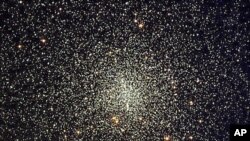Astrophysicists in Britain say they have pinpointed four white dwarf stars that are each surrounded by a cloud of planetary debris that appears to have a chemical composition similar to that of the Earth. They say this is clear evidence that at least one rocky world once orbited in each of those systems, but now have been destroyed.
A white dwarf is a type of dying star that has reached the final stage of its stellar evolution. Very small and dense, a white dwarf is only about the size of the Earth, but has about the same mass as the Sun.
Using observations from the Hubble space telescope, the University of Warwick scientists made the new discovery during a survey of 80 white dwarfs in an area of space within a few hundred light years of the Sun.
The hallmark of a white dwarf is its pollution-free atmosphere of either hydrogen or helium.
As a star transforms into a white dwarf, however, it may disrupt the orbits of objects in its system with disastrous and rather messy results. Any displaced object - such as a planet or asteroid - knocked out of its orbit and unlucky enough to collide with the star, will be destroyed. The obvious telltale sign of the cataclysm is a murky halo of dust and debris encircling the usually pristine white dwarf.
The study co-authors say the chemical diversity of the debris indicates the four white dwarfs likely collided with rocky super-Earths - a category of planet outside of our solar system with a mass no more than 10 times that of the Earth. The analysis revealed that the most abundant elements contained in the dust fields are oxygen, magnesium, iron and silicon. Those same elements account for 93 percent of the Earth’s chemical composition.
The astrophysicists say even more important is the discovery that the planetary remains contained an extremely low proportion of carbon, which very closely matched the proportion of the element in the Earth and the other rocky worlds orbiting closest to the Sun. They say this is the first time that such low carbon ratios have been measured in the atmospheres of white dwarfs polluted with debris.
The researchers say the Hubble observations appear to show one of the four white dwarfs in the very act of devouring the remnant core material of a pulverized super-Earth. They note this may well be a snapshot of the Earth's ultimate fate in the distant future when our Sun becomes a white dwarf in 5 billion years.
The new University of Warwick-led study is published in the journal, Monthly Notices of the Royal Astronomical Society.
News
White Dwarfs Observed Destroying Super-Earths







